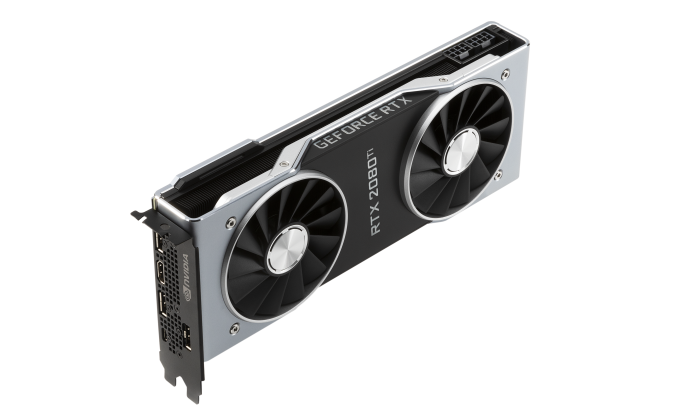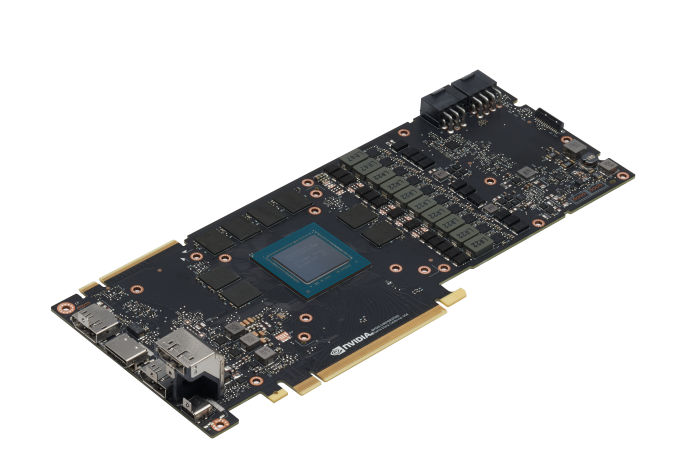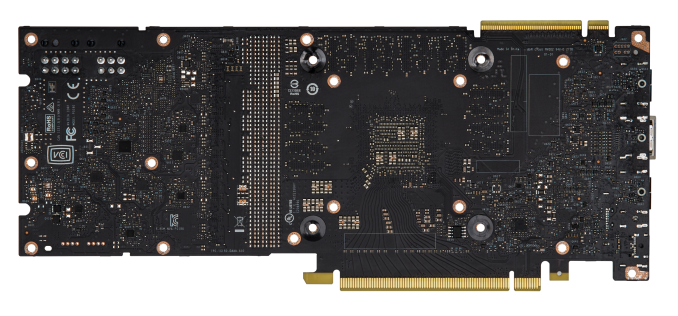The NVIDIA GeForce RTX 2080 Ti & RTX 2080 Founders Edition Review: Foundations For A Ray Traced Future
by Nate Oh on September 19, 2018 5:15 PM EST- Posted in
- GPUs
- Raytrace
- GeForce
- NVIDIA
- DirectX Raytracing
- Turing
- GeForce RTX
Meet The GeForce RTX 2080 Ti & RTX 2080 Founders Editions Cards
Moving onto the design of the cards, we've already mentioned the biggest change: a new open air cooler design. Along with the Founders Edition specification changes, the cards might be considered 'reference' in that they remain a first-party video card sold direct by NVIDIA, but strictly-speaking they are not because they no longer carry reference specifications.
Otherwise, NVIDIA's industrial design language prevails, and the RTX cards bring a sleek flattened aesthetic over the polygonal shroud of the 10 series. The silver shroud now encapsulates an integrated backplate, and in keeping with the presentation, the NVLink SLI connectors have a removable cover.
Internally, the dual 13-blade fans accompany a full-length vapor chamber and component baseplate, connected to a dual-slot aluminum finstack. Looking at improving efficiency and granular power control, the 260W RTX 2080 Ti Founders Edition features a 13-phase iMON DrMOS power subsystem with a dedicated 3-phase system for the 14 Gbps GDDR6, while the 225W RTX 2080 Founders Edition weighing in with 8-phases main and 2-phases memory.
As is typical with higher quality designs, NVIDIA is pushing overclocking, and for one that means a dual 8-pin PCIe power configuration for the 2080 Ti; on paper, this puts the maximum draw at 375W, though specifications-wise the TDP of the 2080 Ti Founders Edition against the 1080 Ti Founders Edition is only 10W higher. The RTX 2080 Founders Edition has the more drastic jump, however, with 8+6 pins and a 45W increase over the 1080's lone 8 pin and 180W TDP. Ultimately, it's a steady increase from the power-sipping GTX 980's 165W.
One of the more understated changes comes with the display outputs, which thanks to Turing's new display controller now features DisplayPort 1.4 and DSC support, the latter of which is part of the DP1.4 spec. The eye-catching addition is the VR-centric USB-C VirtualLink port, which also carries an associated 30W not included in the overall TDP.
Something to note is that this change in reference design, combined with the seemingly inherent low-volume nature of the Turing GPUs, cuts into an often overlooked but highly important aspect of GPU sales: big OEMs in the desktop and mobile space. Boutique system integrators will happily incorporate the pricier higher-end parts but from the OEM’s perspective, the GeForce RTX cards are not just priced into a new range beyond existing ones but also bringing higher TDPs and no longer equipped with blower-style coolers in its ‘reference’ implementation.
Given that OEMs often rely on the video card being fully self-exhausting because of a blower, it would certainly preclude a lot of drop-in replacements or upgrades – at least not without further testing. It would be hard to slot into the standard OEM product cycle at the necessary prices, not to mention the added difficulty in marketing. In that respect, there is definitely more to the GeForce RTX 20 series story, and it’s somewhat hard to see OEMs offering GeForce RTX cards. Or even the RT Cores themselves existing below the RTX 2070, just on basis of the raw performance needed for real time ray tracing effects at reasonable resolutions and playable framerates. So it will be very interesting to see how the rest of NVIDIA’s product stack unfolds.
















337 Comments
View All Comments
tamalero - Wednesday, September 19, 2018 - link
Unlike a video card, DVD were a STANDARD. set to replace the DVD. This wasn't a war between BETAMAX and VHS again. It was an evolution.And as you said it, they had a few titles coming on.
Nvidia currently is offering ZERO options for what they charge insanely.
Even those 4k TVs you mentioned.. had demos and downlodable content.
It was the future.
Nvidia's game in some of these RTX features are solely of Nvidia, not a global standard.
tamalero - Wednesday, September 19, 2018 - link
Errata: set to replace the "CDS" not DVDs.. They do really need an edit button here.Writer's Block - Monday, October 1, 2018 - link
Not a great comparrison.Mainly because: games making use of RTX and othe new features is: Zero.
OlED and 4k/DVD/Blue: pretty much zero/extremely small/dozen or so - not of the aforementioned is as low as zero, so the consumer could see what they were getting.
boozed - Wednesday, September 19, 2018 - link
Early adopters have always paid over the odds for an immature experience. That's the decision they make. You pays your money and you takes your chances...Gastec - Thursday, September 27, 2018 - link
Yes, drug addicts would also agreeianmills - Wednesday, September 19, 2018 - link
RTX - Radeon technology cross off the list. Nvidia is free to price as they please XDNikosD - Wednesday, September 19, 2018 - link
1080 Ti vs 980 Ti ~ 70% for 50$ more MSRP1080 vs 980 ~ 60% for 50$ more MSRP
2080 Ti vs 1080 Ti ~ 30% for 300$ more MSRP (actual price difference is a lot more)
Please, let's boycott Turing cards.
nVidia must learn its lesson.
Skip it.
V900 - Wednesday, September 19, 2018 - link
If you look at AMDs Vega and compare it with the previous AMD flagship: Fury, you see a similar 30-40% increase in performance.In other words: This isn’t Nvidia wanting to rip gamers off, it’s just a consequence of GPU makers pushing up against the end of Moore’s law.
formulaLS - Wednesday, September 19, 2018 - link
It IS nVidia wanting to rip off gamers. Their prices are absolutely a huge rip off for what you get.DigitalFreak - Wednesday, September 19, 2018 - link
Blame AMD for not competing. Nvidia would never be able to do this if AMD had a competitive offering.